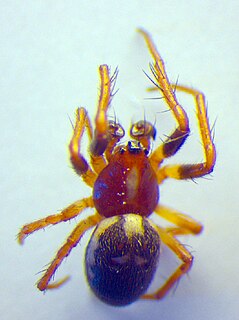
The genus Argiope includes rather large spiders that often have a strikingly coloured abdomen. These spiders are distributed throughout the world. Most countries in tropical or temperate climates host one or more species that are similar in appearance. The etymology of Argiope is from a Latin word argentum meaning silver. The carapace of Argiope species is typically covered in silvery hairs, and when crawling in the sun, they reflect it in a way that gives them a metallic, white appearance.

Theridiidae, also known as the tangle-web spiders, cobweb spiders and comb-footed spiders, is a large family of araneomorph spiders first described by Carl Jakob Sundevall in 1833. This diverse, globally distributed family includes over 3,000 species in 124 genera, and is the most common arthropod found in human dwellings throughout the world.

Glaucus atlanticus is a species of small, blue sea slug, a pelagic aeolid nudibranch, a shell-less gastropod mollusk in the family Glaucidae.

Colonel Frank Wall was a physician and herpetologist who lived in Sri Lanka and India.

Episinus is a genus of comb-footed spiders that was first described by Pierre André Latreille in 1809.

Tegenaria parietina is a rather rare spider in Europe, with a distribution also including Northern Africa to Central Asia and Sri Lanka, and from the West Indies to Uruguay and Argentina, where it may be introduced. In the UK it is sometimes known as the cardinal spider because of the legend that Cardinal Wolsey was terrified by this species at Hampton Court, or, conversely, because he regarded them as lucky and forbade anyone to harm them. In 2013, Tegenaria taprobanica was included in this species.

Uperodon taprobanicus, also known as the Sri Lankan bullfrog, Sri Lankan painted frog, Sri Lankan kaloula, Ceylon kaloula, Indian painted frog, or painted globular frog, is a species of narrow-mouthed frog found in Nepal, Bangladesh, southern and eastern India, and Sri Lanka up to an altitude of about 1300 metres. It can grow to an adult length of up to 75 millimetres(7.5 cm) long from snout to vent. It was originally described as a subspecies of Kaloula pulchra, ssp. taprobanica. The IUCN lists it as being of "Least Concern".

Spiders are air-breathing arthropods that have eight legs, chelicerae with fangs generally able to inject venom, and spinnerets that extrude silk. They are the largest order of arachnids and rank seventh in total species diversity among all orders of organisms. Spiders are found worldwide on every continent except for Antarctica, and have become established in nearly every habitat with the exceptions of air and sea colonization. As of July 2019, at least 48,200 spider species, and 120 families have been recorded by taxonomists. However, there has been dissension within the scientific community as to how all these families should be classified, as evidenced by the over 20 different classifications that have been proposed since 1900.

Hypsosinga is a genus of orb-weaver spiders first described by Anton Ausserer in 1871. The genus name is derived from the Greek "hypso", meaning "high", referring to the higher clypeus than those of the genus Singa.

Chrysopelea taprobanica, the Sri Lankan flying snake or Indian flying snake, is a species of gliding snake distributed in India and Sri Lanka. It can glide, as with all species of its genus Chrysopelea, by stretching the body into a flattened strip using its ribs. The snake is known as "dangara dandaa - දඟරදන්ඩා" in Sinhala, due to its folding postures.
Neoheterophrictus madraspatanus is a species of spider in the family Theraphosidae, found in India.
Argiope taprobanica is a species of spider of the genus Argiope. It is endemic to Sri Lanka.
Hypsosinga taprobanica, is a species of spider of the genus Hypsosinga. It is endemic to Sri Lanka.
Ariadna taprobanica is a species of spider of the genus Ariadna. It is endemic to Sri Lanka.
Alistra is a genus of dwarf sheet spiders that was first described by Tamerlan Thorell in 1894.
Alistra taprobanica is a species of spider of the genus Alistra. It is endemic to Sri Lanka.
Speocera taprobanica is a species of spider of the genus Speocera. It is endemic to Sri Lanka.
Gamasomorpha taprobanica, is a species of spider of the genus Gamasomorpha. It is endemic to Sri Lanka.
Janula is a genus of comb-footed spiders that was first described by Embrik Strand in 1932. It is a senior synonym of Monetoculus.









